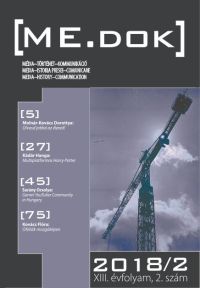Oféliák mozgóképen: Stanley Kubrick Lady Lyndonjától
Enyedi Ildikó Máriájáig
Ophelias on Moving Images: from Stanley Kubrick’s Lady Lyndon to Idikó Enyedi’s Mária
Author(s): Flóra KovácsSubject(s): Media studies, Theory of Communication, Film / Cinema / Cinematography
Published by: Medea Egyesület
Keywords: Ophelia; woman; actress; movie; Kubrick; Ildikó Enyedi
Summary/Abstract: Lady Lyndon is a central character of Stanley Kubrick’s movie, Barry Lyndon (1974), with the second part of the fi lm’snarrative based on her haunting presence. She was the most important persona in the case of my research, with two motifs:silence and immobility appearing to be the key components in her form. Are the lack of words and of activity only strengtheningthe scenic sight in this and other fi lms like The French Lieutenant’s Woman (1981, Karel Reisz), Orlando (1992, Sally Potter), OnBody and Soul (2017, Ildikó Enyedi), The Shape of Water (Guillermo del Toro, 2017) - or do they indicate underlying content?In the fi rst part of my research I examine such places where moments and gestures of female intimacy appear in thementioned fi lms. In these scenes the stillness of paintings and sculptures are evoked though various artistic methods that Iexamine in detail. The analyses are structured around an apparently simple question: how do women, immersed in water,become the central theme of these movies? How do they become active characters instead of being in a passive-status role, andhow do they depict themselves in their own mirror?
Journal: ME.DOK Média-Történet-Kommunikáció
- Issue Year: XIII/2018
- Issue No: 2
- Page Range: 75-106
- Page Count: 32
- Language: Hungarian

